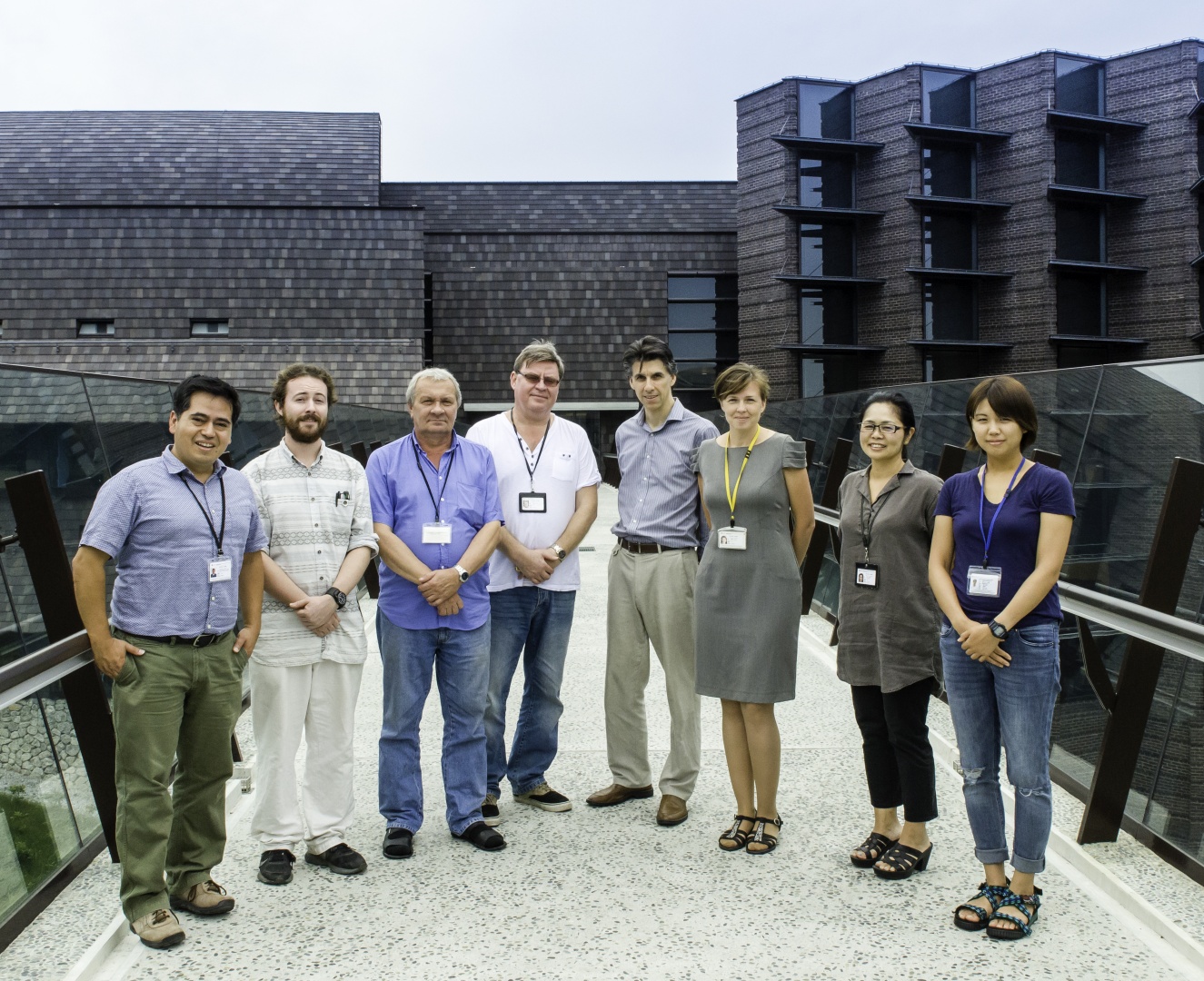FY2014 Annual Report
Biological Systems Unit
Professor (Adjunct) Igor Goryanin
Abstract
Our research in the Biological Systems Unit focuses on wastewater treatment applications for microbial fuel cells (MFCs). Within MFCs complex interactions between microbial populations result in removal of organics and generation of electricity. We seek to understand and manipulate these interactions so as to improve MFC performance characteristics. For instance, differences in anode community composition, as determined by metagenomic sequencing and analysis, are monitored with the ultimate goal of building idealized communities for treatment of specific substrates. Furthermore, we have begun to characterize bacterial isolates of interest though whole genome sequencing and microbiological techniques. A long-term collaboration with a local awamori distillery into and beyond year 2014 established that our pilot scale tray MFC design could efficiently and consistently remove organics from an agro-industrial wastewater.
1. Staff
- Professor Igor Goryanin, PI
- Dr. Michael Cohen, Group Leader
- Dr. Larisa Kiseleva, Staff Scientist
- Dr. Slava Fedorovich, Staff Scientist
- Dr. Jovan Rebolledo-Mendez, Staff Scientist
- Mr. David Simpson, Technical Staff
- Ms. Irina Khilyas, Research Intern
- Ms. Koharu Okada, Research Intern
- Ms. Shizuka Kuda, Research Administrator
2. Collaborations
- Theme: Microbial Fuel Cell deployment for treatment of tofu wastewater
- Type of collaboration: Research/Demonstration Project Collaboration
- Create-ES Co., Ltd. (construction)
- OP Environment Science Center (analysis)
- Researchers:
- Professor Hideo Yamasaki, Faculty of Science, University of Ryukyus, Okinawa, Japan
- Theme: Biology of Microbial Fuel Cells
- Type of collaboration: Joint research
- Researchers:
- Professor Anatoly Sorokin, Institute of Biophysics, RAS, Pushchino, Russia
- Professor Mikhail Gelfand, Institute for Information Transmission Problems, RAS, Russia
- Theme: Improvement of Microbial Fuel Cell performance using nanotechnologies
- Type of collaboration: Joint research
- Researchers:
- Professor Mukhles Sowwan, Nanoparticles by Desighn Unit, OIST
- Theme: Microbial Fuel Cell treatment of whisky distillery wastewater
- Type of collaboration: Joint research
- Researchers:
- Professor Alan Harper, Heriot Watt University, Edinburgh, UK
- Theme: Microbial Fuel Cell treatmenet of winery wastewater
- Type of collaboration: Research
- Researchers:
- Prof. Farid Farahmand, Department of Engineering Science, Sonoma State University, California, USA
3. Activities and Findings
3.1 Pig farm wastewater treatment with lab-scale MFCs
Agriculture is a primary sector of economy in many countries and produces considerable amounts of organic wastes that require proper treatment and disposal. Wastewater generated by the rapidly growing swine industry contains high concentrations of organic compounds, ammonia, phosphates, odorous gases, suspended solids, and pathogens. Common methods of treating swine wastewater (SW) include aerobic oxidation ponds, lagoons, anaerobic digestion and constructed wetlands. One of the primary treatment targets of SW is its particularly noxious set of odoriferous constituents, which are primarily volatile fatty acids (VFAs).
For this study we investigated the activity of two pairs of independently operated semi-batch SW-fed MFCs. The source microbial community in one MFC pair was the SW itself whereas the other pair was inoculated with industrial granular brewery sludge (IGBS). We show that both systems substantially lower the chemical oxygen demand and VFA of the SW and that the efficiency of these activities can be improved through alteration of the feed pH (Fig. 1), feed strength, hydraulic retention time and external circuit resistance. The consistently higher current production by the SW-inoculated MFC illustrates an importance of initial microbial colonization on subsequent performance. Acidification of SW improved COD and VFA removal by both types of MFCs. Doubling the HRT of the high-strength SW-fed MFCs improved the removal of COD and, for the SW-inoculated MFC, VFAs from the SW. Maximum Coulombic efficiency occurred at a lower feed strength than did maximum power density.
Also, genomic DNA from the microbial communities of the initial inoculum and anode surface of each MFC after two months operation were sequenced and have been placed for computational analysis.
We have applied for 40M yen per year OPG grant for 3 years to collaborate with local industry on this project. Collaborators so far include Create-ES (Construction, operation), OP Environment Science Centre, and the Okinawa Livestock Centre.
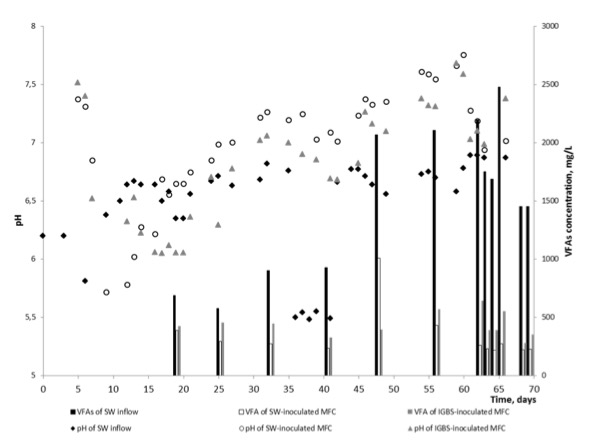
Fig. 1. pH levels and total VFA concentrations in MFCs inoculated with swine waste sludge and brewery sludge. Mean data from duplicate experiments.
3.2 Electricity generation and methane production from anaerobic wastewater treatment in field-scale MFC bioreactors
Conventional municipal, agricultural and industrial wastewater treatment systems are based on energy intensive aerobic biological processes. The goal of several research groups in the world has been developing cost-effective and environment friendly wastewater treatment systems that use substantially less energy than currently employed aeration technologies. Although MFCs have been already shown to simultaneously treat organic waste and generate electricity at a laboratory scale and fed with artificial wastewater, there has been no report so far on successful performance of scaled-up bioreactors fed on actual industrial wastewaters. The purpose of this research is to construct and test an MFC at a practical scale. Throughout 2014 we continued to operate first demonstration of real-world scaled-up microbial fuel cell system capable of treating dilute wastewater from Okinawa local distillery and produce electricity and methane simultaneously.
The bioreactors used in this project study are single chamber and utilize air-breathing cathodes. The flow pattern used is serpentine, with internal baffles to ensure the biomass is fully utilized. Electrode materials are activated carbon, glassy carbon and graphite based. No metals, precious or otherwise are used within the reactor. The electrode design is consistent with the group's objectives to find practical applications for this technology within industry.
The advantages of conducting these trials using our chosen MFC equipment are as follows:
- Proven long term stable performance, especially using real wastewater
- Dual operating modes, with both electrogenic and methanogenic activity supported for direct and indirect power production
- Robust platform to test various operating modes, such as Organic Loading Rate and Retention Time (flow).
- Experience with this type of reactor design and vendor
The substrates used for this pilot project are all real wastewaters produced by the awamori industry. A low strength wastewater produced from washing of rice prior to the introduction of Koji mold and distillation contains concentrations of protein, as well as electrolytes and nutrients. The organic concentration ranges from 800 to 1000 COD. The pilot reactors have also had additional substrates added which are produced from the distillation process itself. This higher strength organic wastewater has a value of 40,000 COD and contains high quantities of suspended solids. The additional organics are added to increase the overall COD value of the pilot influent ensuring the microorganisms have adequate access to organics, and as part of a gradual increase of flow rate and organics concentration.
Pilot scale testing of MFCs is an important step towards commercializing this technology. Without understanding how real world conditions can affect the performance and stability of the reactor, improvements to electrode design and microbial conditioning cannot be adequately quantified. These pilot scale reactor tests have provided clear directions on how to proceed with research and development in the coming years. Working closely with potential operators and interested parties who are outside of the research institution affords valuable feedback and development of know-how and intellectual property.
Two pilot-scale MFC bioreactors, each 60 L active volume and 8 electrode pairs each, were constructed and operated in continuous-flow mode at the Mizuho distillery using rice-wash wastewater as the substrate. The anodic chambers were seeded with the culture of anaerobic microorganisms derived from anaerobic digester. The systems were monitored for BOD removal and power generation across a range of BOD loadings.
During 2014 the wastewater organics concentration at the inlet was increased from 2.5 g/L BOD to 3.5 g/L BOD. BOD removal rates were consistently high, ranging from 92% to 99% (Fig. 2). Daily monitoring of electricity generation and recording of cell voltages and current at open circuit, have demonstrated that the rice wash substrate has enough energy to harvest by electrode. Power density was shown to be 4.8 Wh/m3 (electrogenic only) and 104.6 Wh/m3 (methane only). Electrode efficiency was therefore calculated at 6.64 A/m3 (400 mA/tray module) and 1.07 A/m2 (cathode area). Methane was collected using modified reactor lids, the rate of production as well as the composition was analyzed. It was shown that 50% of MFC biogas is methane, 30% CO2 and 0.1% H2S. 3 liters of biogas is produced in total per day, therefore the rate of production for methane was calculated at 0.025 L methane/L reactor volume/day.
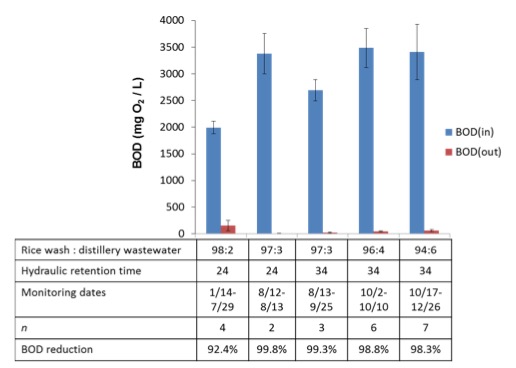
Fig. 2. Mizuho distillery tray-MFC BOD removal results for Year 2014. The monitoring period covered from months 7 to 19 of system operation. Means ± SE.
Microorganisms in the MFC act as a catalyst on the anode surface by breaking down organic substrates to produce electrons and transfer them to an anode surface, and protons that migrate to the cathode. To learn the biochemical processes and molecular mechanisms that underlie the effective MFC operation, we performed deep sequencing of microbial community from the anodic surface of the bioreactors. The large-scale metagenomic analyses identified the biodiversity and structure of community responsible for distillery waste treatment, electricity and methane production. This study suggests that some of previously proposed hypotheses on MFC biofilm formation and presence/absents of certain microbial families should be reconsidered.
First, it had been assumed previously that to successfully start-up and operate an MFC, the prevention of methanogenesis in anode chamber is essential. However, our study shows that methanogenic Archaea successfully coexisted with anaerobic exoelectrogenes (e.g. Geobacter) making the processes of wastewater treatment, electrical power generation and methane production simultaneous.
Second, anaerobic treatment of wastewaters is believed to take longer to accomplish due to the inherently slow growth of anaerobic microorganisms. However, our pilot bioreactors seeded with mixed anaerobic culture of high biodiversity showed fairly fast biofilm formation on the anode surface that helped to achieve stable power output level in 30 days period. Further, we observed gradual biofilm formation within 6 month time period.
Another interesting finding comes from the lab-scale MFC that we ran in parallel with the pilot-scale bioreactors. The study of microbial biofilm from that test lab-scale reactor showed consistent enrichment with helical-shaped bacteria genetically similar to Thalassospira. We isolated these bacteria and tested it as a pure culture for electricity generation in a 170 ml MFC. One-month observation showed stable voltage (0.4 V, in overage) and current (max 9 mA) generation by pure culture of the newly isolated bacterium. This is the first demonstration of power production by pure culture of non-rod-shaped bacteria. The USPP has been submitted.
We are currently testing various means to remove residual nitrogen and phosphorus in MFC effluent use of photosynthesis-based aquatic communities. In parallel, a Slow Sand Filter was also tested for comparison, however it was found SSF would require a much larger area than was available at the site, potential modifications using artificial bio-film media and specially selected bacteria may be tested in future.
Over the course of this pilot study many modifications have been performed to the equipment during operation. Before commencing any changes to the system, it was ensured at least 6 complete retention times had been completed to ensure stable operating conditions. Adjustment of inlet pH to the range 6.8 to 7.2 ensured predictable performance. Additional storage at the pilot site has compensated for the distillery's batch based production schedule and allowed for greater system flow and in turn a reduction of Hydraulic Retention Time (HRT). Separation of inlet drums followed by the division of the 60 L MFC modules into independent 26 L modules with a shared 8L final volume allowed for the continuous testing of the MFC equipment at differing concentrations of substrate and flow. MFC1 was dedicated to higher Organic Loading Rates (OLR) and MFC2 was dedicated to lower HRTs. Gas collection has been improved to compensate for higher internal pressures brought about by higher flow rates. Biogas is now collected and delivered to the PBR system as a pre-treatment. This allows for the reduction of CO2 as well as removal of any H2S gas, preparing the methane for use.
Several other pilot studies using MFCs have been conducted by research groups, however not in the area of awamori wastewater treatment. This study is the first demonstration of the full-scale microbial fuel cell systems capable of simultaneously running three processes: low-strength wastewater treatment, electricity generation, and methane production.
3.3 Isolation and study of microorganisms relevant for bioremediation
Isolation electrogenic bacteria. To obtain magnetic particle-associated bacteria, some of which should be electrogenic, we subjected tidal beach sediment to the enrichment procedure. One MFC was inoculated with a mixed culture derived from the magnetic particle-enriched sediment and the other with an axenic culture of a helical bacterium, strain HJ, isolated from the enriched sediment. Both MFCs were found to produce power, with the current and voltage generated from the mixed culture MFC being substantially higher. The comparatively low power density observed of strain HJ is typical of axenic bacterial cultures relative to that of the communities from which they are derived. At the end of the experiment strain HJ was reisolated from the MFC to confirm its retention (Kiseleva et al. 2015, BioMed Research International, Article ID 582471).
Strain HJ was identified by means of microscopic analysis (Fig. 3) and 16S rRNA gene sequence comparisons (Fig. 4) to be of the genus Thalassospira. TEM images show cells of 0.5-0.7 µm width and 1.5-5.7 µm length having single polar flagella typical of the genus Thalassospira, with evidence of both symmetric and asymmetric cell division. One or more electron-dense staining regions can be seen within most cells. Cells were motile, stained Gram negative and tested positive for catalase and oxidase activity. Growth occurred on Marine Agar at temperatures ranging from 12°C to 39°C and pH values ranging from 5.5 to 10.5. The closest matching 16S rRNA gene sequence to a named species the GenBank database was with that of Thalassospira profundimaris strain WP0211 (1449/1453, 99.7% identity), which notably differs from strain HJ in its lack of flagella.

Fig. 3. Transmission electron micrographs of Thalassospira sp. strain HJ showing various features. (A) A single polar flagellum; (B) intracellular electron-dense regions; (C) symmetric cell division; and (D) asymmetric cell division. Representative images are shown.
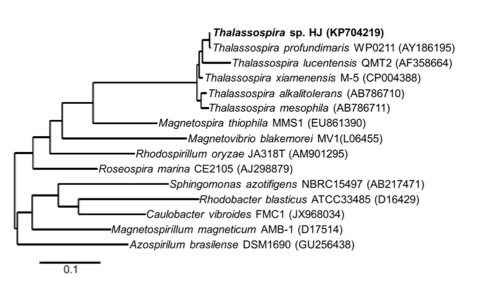
Fig. 4. Phylogenetic tree of strain HJ and selected alphaproteobacteria based on 16S rRNA gene sequences. The tree was constructed from sequences aligned by MUSCLE using maximum-likelihood method of PhyML 3. The scale bar reflects evolutionary distance, measured in units of substitution per nucleotide site.
Electrical power production by pure culture. Micro-MFC chambers inoculated with axenic cultures of Thalassospira sp. strain HJ and, for comparison, Geobacter daltonii and Desulfamplus magnetomortis showed electrical current production immediately after inoculation but differed in the intensity and shape of the subsequent production curve. Thalassospira sp. strain HJ and D. magnetomortis displayed gradual increases in current after initiation whereas current production from G. daltonii decreased with time. After 172 h, the current for all axenic cultures decreased to 5-8 mA, which was attributed with C-source depletion. Voltage drop was observed after 144 h from the strain HJ-inoculated micro-MFC, whereas G. daltonii and D. magnetomortis MFCs demonstrated voltage loss after 48 h. As a control, to determine the contribution of growth medium components to current and voltage production, a micro-MFC was filled with sterile medium. Although there was no observable current generation background voltage was observed (Figure 5). The maximal single-value power readings from the microMFCs were of 2.6 W m-2 (at 96 h) for Thalassospira sp. strain HJ, 5.5 W m-2 (at 144 h) for D. magnetomortis, and 4.6 W m-2 (at 24 h) for G. daltonii. Geobacter is a well-characterized genus of electrogenic bacteria but we are not aware of prior reports of electrogenicity by the magnetotactic bacterium D. magnetomortis. We hypothesize that magnetosomes could confer a selective benefit by enabling bacteria to hone in on ferromagnetic external electron acceptors. A wider survey of magentotactic bacteria for electrogenecity would be warranted.
Recently, a marine sediment-derived Thalassospria sp. isolate was reported to exhibit electroactive behavior by accepting electrons from a sulfur cathode; the capacity of the strain to reduce an anode as we have found here of Thalassospria sp. strain HJ was not examined in that study.
Generation of a genome-wide metabolic network for the electrogenic Thalassopira sp. strain HJ (Collaboration with Prof Anatoly Sorokin, Institute of Biophysics, RAS, Pushchino). A metabolic network was generated by genomic sequence analysis of the marine bacterium Thalassospira sp. strain HJ (Kiseleva et al. 2015). All contigs ≥10 kbp and longer were submitted to the RAST automatic annotation pipeline. The automatic gap filling process using the SEED Model was performed with ‘Complete medium’, which assumes all compounds able to enter the cell either by diffusion or by predicted transporters to be available at unlimited amounts. Manual gap filling was performed to allow the network to synthesize full range of biomass components from chemicals in SP4 or M1 anaerobic media as defined in The SEED model media formulation collections. For some missing reactions genes were identified by pairwise blast with known genes from five reference genomes and were included in the reconstructed network. In the case when blast gave no results or quality of alignment was pure, reactions were added to the model as non-gene associated reactions. In total the reconstruction contains 93 reactions without genes associated with them. Another 55 reactions contains incomplete definition of multisubunit complexes. Major gaps were identified in phenylalanine, tyrosine and tryptophan biosynthesis and fatty acid metabolism. Further analysis and identification of complete genome sequence will allow us identify enzymes for those reactions.
The reconstruction describe metabolic network of 1076 compounds and 1215 reactions (see Fig. 5 for examples). Out of 3991 genes 1035 are associated with at least one reaction. 165 genes are associated with 95 transport reactions. About a half of the transport reactions (59) are associated with the ABC transporter genes and specificity.
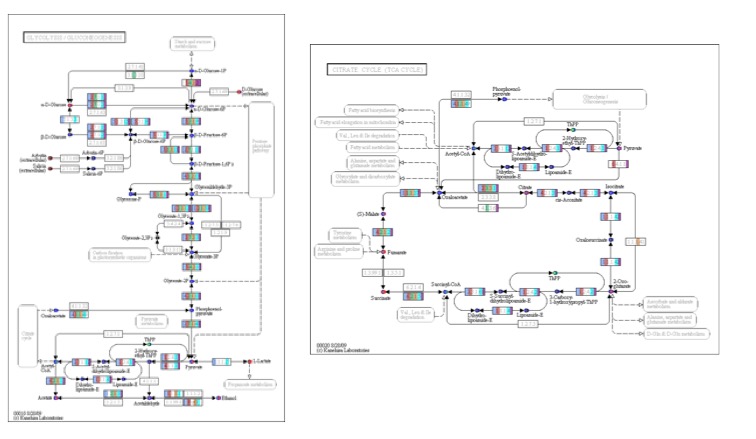
Fig. 5. Metabolic reconstruction of the glycolysis (left) and the oxidative citric acid cycle (right) in Thalassospira sp. strain HJ.
When the modelled cell were able to produce nonzero biomass at the SP4 medium the only limiting compounds for M1 Anaerobic medium were Spermidine (KEGG C00315) and Thiamine (KEGG C00378). Addition of both of them to the media allowed the cell to grow on 260 out of 526 media formulations from The SEED Model.
Further, we performed flux balance analysis (FBA) of the genome-scale metabolic network to compute the fundamental metabolic potential of Thalassospira sp. HJ with reaction stoichiometry, given a realistic nutrient uptake rate (Sorokin et al. 2015, unpublished).
The model is able to produce electricity in MET mode if modified according to Mao and Verwoerd (2013) but unlike the Geobacter metallireducense model in the paper Thalassospira sp. HJ model was not able to gradually regulate energy uptake by biomass reaction, which means that not all futile cycles were broken by following this modified approach.
3.4 Next generation sequencing of metagenomes and microbial community structure analysis
Efficiency of extracellular electron transfer and biodegradation by microorganisms is crucial for MFC performance. Under the conditions of operating MFC, the initial microbial community eventually transforms and becomes enriched with anode-respiring bacteria. We used next-generation sequencing in order to observe tendencies in microbial community development in the operating MFCs. The methods of directed evolution were applied to communities of different origin (marine sediment, anaerobic digester sludge, pig farm wastewaters) inoculated into laboratory- or pilot-scale MFCs.
Microbial community structure from two field-scale MFC bioreactors. Two multi-electrode pilot MFC bioreactors of similar design successfully treated wastewater from local distilleries and generated electrical power; one in Edinburgh, Scotland (UK), the other in Okinawa, Japan (JP). Each MFC was independently inoculated with a local anaerobic digester sludge and maintained under ambient conditions with average temperatures of 10°C and 27°C for the UK and JP reactor, respectively. The UK bioreactor was fed whisky pot ale wastewater while the JP bioreactor was fed rice wash and spentwash mixed awamori distillery wastewater. The pH level in UK bioreactor was maintained at 5.5 in order to reduce possible methanogenic activities that are considered to decrease electrical power output, while it was adjusted to pH 6.2 in the JP MFC in order to increase organics digestion.
In order to observe community development and compare metabolic characteristics of microbial consortia from different bioreactors, whole community genomic DNA was isolated from the initial inoculums (UK-ref and JP-ref) and from anodic biofilms of MFCs operating for 90 d and 70 d (UK-mfc and JP-mfc, respectively). Shotgun sequence data were generated for each metagenomic library and further used for taxonomic and functional analysis.
The initial anaerobic sludge communities used for MFC inoculation differed by structure and diversity. The UK initial inoculum community (UK-ref) consisted of Bacteroidetes, Firmicutes, Proteobacteria and Actinobacteria, with Bacteroidetes constituting over a half of the population. The JP initial inoculum (JP-ref) was more complex in terms of biodiversity. Apart from the aforementioned groups found in the UK-ref, the JP-ref community contained a significant proportion of Archaea and a few less represented bacterial phyla including Chloroflexi, Thermotogae, Spirochaetes, Planctomycetes, Acidobacteria, Verrucomicrobia, Deinococcus-Thermus and Cyanobacteria. Proteobacteria was the most abundant group in the JP-ref sample.
Both initial communities underwent structural changes within two to three months of MFC operation. In the UK anode biofilm (UK-mfc), the proportions of Proteobacteria, Firmicutes and Actinobacteria increased compared to their abundance in the inoculum sludge. Bacteroidetes, although decreased in proportion to other bacterial groups, remained the most abundant phyla in the community. At the genus level, the most significant increase was shown for Pseudomonas and Lactobacillus.
In the JP anode biofilm (JP-mfc), Bacteroidetes, Firmicutes and Archaea increased in abundance throughout MFC operation. Proteobacteria remained the most represented in the JP-mfc, although its fraction decreased compared to the corresponding initial community. At the genus level, Clostridium, Bacteroides, Prevotella, Pelobacter, Geobacter, Paludibacter and Methanothermobacter were enriched in JP-mfc. Additional analysis of microbial DNA from different anodic components showed that the latter three genera and species related to Roseiflexus tend to accumulate on carbon cloth rather than on carbon granules. Thus, taxonomic analysis showed that Bacteroidetes, Firmicutes and Proteobacteria are present in distinct anaerobic sludge communities and dominant in MFCs fed by real industrial wastewater under different environmental and operational conditions.
3.5 Metabolic reconstruction and functional analysis of MFC microbial communities
In microbial systems, taxonomic diversity is not necessarily related to functional diversity. We performed metagenome-based functional analysis of microbial communities (Kiseleva et al. 2015, in press) from MFC bioreactors operated in Okinawa (JP-mfc) and Edinburgh (UK-mfc). Besides general functional categories, we looked particularly into distribution of genes and pathways associated with bioremediation and extracellular electron transfer, two major functions of MFC communities.
Metagenome-wide screening of anode biofilm sequences showed the presence of the key genes for both direct and indirect extracellular electron transfer types in both bioreactors. However, the distribution of these genes and their taxonomic assignment differed between the two MFCs (Fig. 6).
The distribution of genes and pathways involved in biodegradation of the main components of distillery wastewaters, such as acetate, cellulose, starch and proteins was identified for anode biofilm communities. All examined pathways were introduced by higher number of microbial species in the more diverse JP-mfc populations.
The main acetate-catabolizing enzymes (acetyl-CoA synthetase, phosphate acetyltransferase, acetate kinase, acetate permease, glyoxalate cycle enzymes) were mostly distributed between Proteobacteria, Firmicutes and Archaea. Distribution of key enzymes involved in anaerobic cellulose degradation (endogluconase, beta-glucosidase and exoglucanase) showed that Firmicutes were possibly the major cellulose digesters in both bioreactors. Starch was utilized mostly by abundant Firmicutes, Bacteroidetes and Proteobacteria in both MFCs, and also Archaea in JP-mfc.
Extracellular protein degradation can be performed by various proteases produced by different groups of microorganisms. An indirect way to determine the main contributors of proteolysis consists of searching for amino acid transporter genes in the community. Functional analysis showed that Clostridia might be the major bacterial family carrying out this function in both MFCs, with the help of Lactobacillus in the UK and Delta- and Gammaproteobacteria and Archaea in JP-mfc.

Fig. 6. Functional profile of MFC microbiomes, and distribution of different types of proteins involved in electron transduction among different phylogenetic groups on anodic biofilm. (a,b) Representation of the most abundant orthologous groups in the anode biofilm, represented by at least by 0.25% in (a) UK MFC or (b) JP MFC as determined by assignment to the COG database by MG-RAST. Orthologous groups are colored by their representative functional category; translucent bands represent the abundance in corresponding reference metagenomes. (c,d) Distribution of homologous of known proteins involved in extracellular electron transfer determined by BLAST (similarity 45%, E-value 10-5, alignment length at least 60 aa) plotted on NCBI taxonomy tree for (c) UK MFC and (d) JP MFC. Branches are colored according to the phylum level, circles on the branches indicate the presence of particular type of proteins in this phylogenetic group.
Besides the genes involved in extracellular transfer, we checked the most abundant molecular functions and genes responsible for bioremediation in both MFC bioreactors. Identified proteins were distributed among all existing Clusters of Orthologous Groups (COGs) functional categories with “Carbohydrate transport and metabolism” and “Energy production and conversion” pathways overrepresented in the UK and JP bioreactor communities, accordingly. Linking identified functions to taxonomy showed that enriched pathways were introduced mostly by highly abundant phyla. In the UK bioreactor, the dominant group of Bacteroidetes was comprised of saccharolytic bacteria that derive energy primarily from carbohydrates and proteins through fermentation, and therefore hold a number of genes for carbon utilization. The enrichment of “Energy production and conversion” functional category in JP-mfc was caused mostly by Archaea that added to methane metabolism pathways, as well as by Proteobacteria and Firmicutes.
Increased number of genes associated with motility, chemotaxis, signal transduction and membrane transport were found in the anodic biofilms compared to initial inoculums. The most enriched proteins were critical for biofilm formation or important for energy utilization. Functional comparison between inoculum and anode communities showed gene enrichment in “Coenzyme transport and metabolism”, “General function prediction only” and “Function unknown” categories on anode biofilms implying roles of yet unknown proteins in anodic biofilm formation and functioning.
4. Publications
4.1 Journals
- Dimou O., Andresen J., Fedorovich V., Goryanin I., Harper A., and D. Simpson. Optimisation of scale-up of microbial fuel cell for sustainable wastewater treatment with positive net energy generation. New Biotechnology 31, S213, 2014
4.2 Books and other one-time publications
Nothing to report
4.3 Oral and Poster Presentations
-
I. Goryanin (2014) “Microbial Fuel Cells.” Invited Speaker, Lecture, Sonoma State University
-
I. Goryanin (2014) “Microbial Fuel cells. Industrial applications for waste water treatment”. Invited lecture, Tianjin Institute of Industrial Biotechnology, Chinese Academy of Science
-
I. Goryanin (2014) “Microbial Fuel Cells. Science” Invite lecture, Tianjin University
-
O. Dimou, D. Simpson, J. Anderson, I. Goryanin, A. Harper (2014), Optimisation for scale-up of Microbial Fuel Cell for sustainable wastewater treatment with positive net energy generation, European Congress in Biotechnology (ECB16) Edinburgh, UK (poster)
-
Cohen M.F., Simpson D., Kiseleva, L., and I. Goryanin (2015). Application of microbial fuel cells for recycling distillery and winery wastewaters. Water Resources and Policy Initiatives Annual Conference. Fresno, California, USA. Oral presentation, April 2015
5. Intellectual Property Rights and Other Specific Achievements
Unit Inventions
a. Novel electrogenic bacteria (filed USPPA, 2015)
b. Autonomous Chemotactic Underwater Robot (disclosure filed, 2015)
c. Novel tubular MFC design (disclosure filed, 2015)
6. Meetings and Events
Nothing to report
7. Other
Nothing to report.




